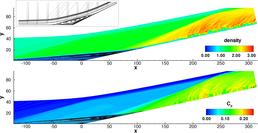Laminar to Turbulent Transition in Hypersonic Flows
- Started
- 8th March 2010
- Ended
- 8th July 2010
- Research Team
- Neil Sandham, Heinrich Luedeke

Transitional supersonic flow over a ramp with re-circulation. Density and pressure in the flow field. Top left: sketch of the flow structure on the ramp.
Despite intensive theoretical and experimental research, transition to turbulence in separated hypersonic ramp flows is still a challenge to predict.
In fluid dynamics, turbulence is a fluid regime characterized by chaotic, stochastic property changes and in such a way difficult to describe. On the other hand a laminar flow is a well ordered flow state of a fluid that flows in parallel layers, with no disruption between the layers. Most challenging to predict is the so called transitional regime that describes the transfer from the laminar state into the turbulent one and is one objective of the present project.
One of the most successful approaches to model the dominant mechanisms in this state is direct numerical simulation of the turbulent flow, which has demonstrated the capability to generate reliable data. This technique resolves all scales of the chaotic flow field by using the basic fluid dynamic equations and is by this demand also a computational expensive technique. In the present study, supersonic test cases are chosen and simulated by using a highly accurate version of the DLR flow solver FLOWer, used widely in academia and industry like Airbus.
With various validations as a background, a supersonic ramp flow at about the fivefold speed of sound was chosen for simulations. Different ramp-angles and flow conditions were investigated to determine a transitional test case, for which turbulence can be resolved behind re-attachment. A hypersonic ramp with 12 degree ramp angle was then chosen for three-dimensional simulations of the transition process. These DNS were carried out with different grid extents in the wall-normal direction and different sweep angles of the incoming flow with good success. Simulations of laminar-turbulent breakdown are carried out by using different white-noise perturbation profiles at the inflow to trigger the transition process in a defined way.
Categories
Physical Systems and Engineering simulation: CFD
Algorithms and computational methods: Finite differences
Visualisation and data handling methods: Surface imaging, Voxel imaging
Simulation software: FLOWer
Visualisation and data handling software: ParaView, TecPlot
Programming languages and libraries: Fortran
Computational platforms: Iridis, Linux
Transdisciplinary tags: Scientific Computing